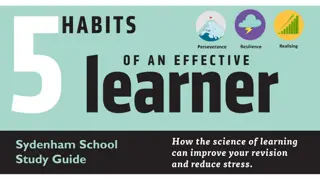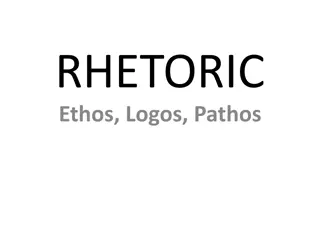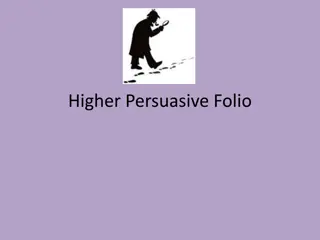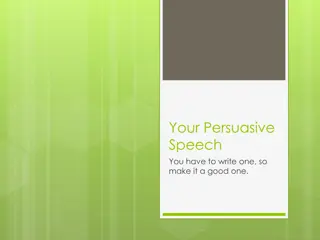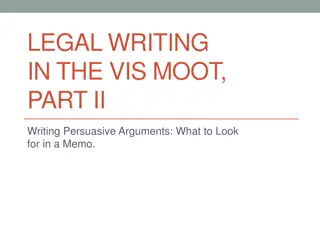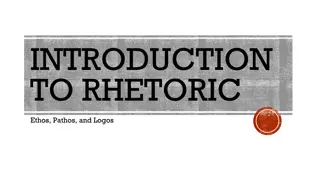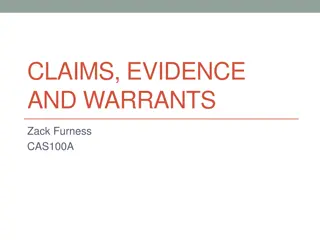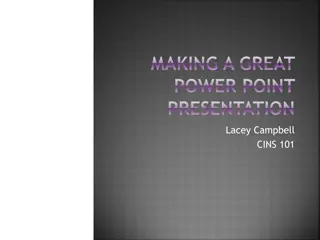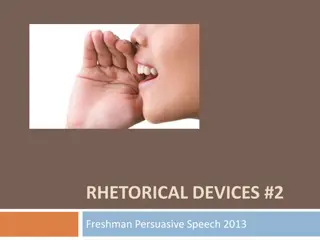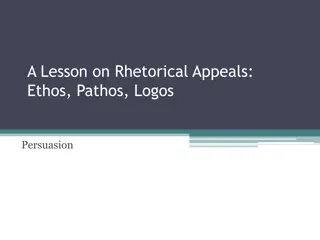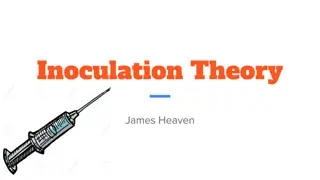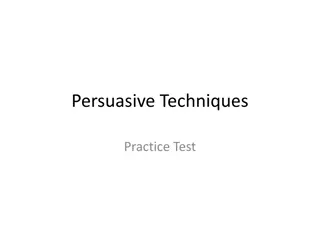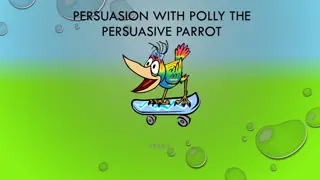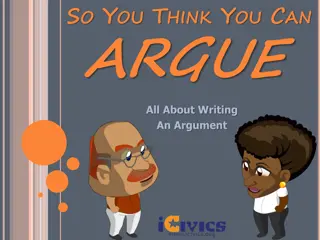Mastering the Art of Persuasive Presentations
Crafting a killer presentation involves establishing credibility, framing for common ground, providing evidence, and connecting emotionally. Structuring your presentation effectively, simplifying key points, and finishing strong are essential for engaging your audience and leaving a lasting impact.
Download Presentation

Please find below an Image/Link to download the presentation.
The content on the website is provided AS IS for your information and personal use only. It may not be sold, licensed, or shared on other websites without obtaining consent from the author.If you encounter any issues during the download, it is possible that the publisher has removed the file from their server.
You are allowed to download the files provided on this website for personal or commercial use, subject to the condition that they are used lawfully. All files are the property of their respective owners.
The content on the website is provided AS IS for your information and personal use only. It may not be sold, licensed, or shared on other websites without obtaining consent from the author.
E N D
Presentation Transcript
Tips on Making a Killer Presentation
The Four Steps to a Persuasive Presentation * 1. Establish Credibility 2. Frame for Common Ground 3. Provide Evidence 4. Connect Emotionally * The Necessary Art of Persuasion, Jay A. Conger, Harvard Business Review, May-June, 1998
Establish Credibility Demonstrate expertise Company Your organization Yourself Education Experience
Frame for Common Ground Frame as a potential loss if supply is low or demand is high. Frame positively as a win otherwise. Frame every offer and deal term positively, as a benefit (WIIFM)
Provide Evidence Facts Research Success stories Features, Advantages, Benefits, Benefits, Benefits, Benefits, Benefits, Benefits, Benefits, Benefits, Benefits, Benefits
Connect Emotionally Rapport Empathy Cooperation Understanding Fairness Caring Trust Liking
Structure effectively Follow the right sequence. Primacy and recency People remember best the first and last things they hear in a presentation. Get the most important thing out right away. Tell emwhat you re going to tell em, tell em, then tell em what you told em. Draw Connections Among Elements. Good connections help people remember. Make the audience work. Ask questions. Make audience think and they will remember more.
Structure effectively Be immediately interesting. Simplify and exaggerate Your audience can remember only a few details, so streamline you delivery and exaggerate the delivery of your main points. Finish strong. People instinctually crave strong, simple resolutions. Refer back to your opening lines to bring the story full circle.
You Get Back What You Give Positive Understanding Fairness Caring Trust Negative Fear Uncomfortableness Remoteness Passivity/Low Energy Unengaged
Presenting to Groups Use PowerPoint Don t use distracting transitions or animations Clearly Define Your Objectives Beforehand. Preparation: Know your subject thoroughly Understand what your audience wants and expects Write a script (but don t memorize it or repeat it word for word) Rehearse, rehearse, rehearse Energetic delivery
Delivery Tips Fit Your Delivery Style To Audience Expectations. Dress One Level Up From Average Audience Style. Poise and Confidence Love Your Product. Be Concise. Keep Jargon To a Minimum No Negatives Don t Be Defensive.
Delivery Tips Smile Establish eye contact with everyone. Vary your voice. Use people s names. Be careful about injecting humor.
Delivery Tips Involve the Audience Tap Into the Decision Maker s Emotions If You Make a Mistake, Keep Going Laugh It Off The audience is with you if they like you. Be Yourself and Have Fun
Delivery Tips Use Slides As a Prompt For Your Narrative Don t Read Slides. Use visuals as prompts, hand out text versions afterwards. Face the Audience, Talk To Individuals (Especially the Decision Maker If There Is One) Announce Up Front How You re Going To Handle Questions. Don t Hand Out Hard Copies of Text Beforehand.
Perfect Mix of data and narrative How to Give a Killer Presentation. (2013). Chris Anderson. Harvard Business Review. June.
Most Presentations Lie Somewhere On The Continuum Between A Report and a Story. A Report Is Data-rich, Exhaustive, and Informative but Not Very Engaging. Stories Help a Speaker Connect With an Audience, But Listeners Often Want Facts and Information, Too. Great Presenters Layer Story and Information Like a Cake, and Understand That Different Types Of Talks Require Differing Ingredients.
Report Story Research Findings Financial Presentations Keynote Address Product Launch VC Pitch How to Give a Killer Presentation. (2013). Chris Anderson. Harvard Business Review. June.
Research Findings If your goal is to communicate information from a written report, send the full document to the audience, and limit the presentation to key takeaways. Don t do a long slide show that repeats all your findings. Anyone who s really interested can read the report; everyone else will appreciate brevity.
Financial Presentation Financial audiences love data, and they ll want the details. Satisfy their analytical appetite with facts, but add a thread of narrative to appeal to their emotional side. Then present the key takeways visually, to help them find meaning in the numbers.
Product Launch Instead of covering only specs and features, focus on the value your product brings to the world. Tell stories that show how real people will use it and why it will change their lives. See Nancy Duarte s book Resonate.
VC Pitch For 30 minutes with a VC, prepare a crisp, well-structured story arc that conveys your idea compellingly in 10 minutes or less; then let Q&A drive the rest of the meeting. Anticipate questions and rehearse clear and concise answers.
Keynote Address Formal talks at big events are high-stakes, high-impact opportunities to take your listeners on a transformative journey. Use a clear story framework and aim to engage them emotionally.
How to Pitch a Brilliant Idea Coming Up With Creative Ideas Is Easy; Selling It To Strangers Is Hard. Problem Has As Much More To Do With Seller s Traits As With the Inherent Quality Of the Idea. Humans Categorize Others In Less Than 150 Milliseconds (Eye Blink), and Within 30 Minutes They ve Made Judgments About Your Character. How to Pitch a Brilliant Idea. (2003). Kimberly Elsbach. Harvard Business Review. September.
Catchers (in Hollywood) of Pitches Categorize Pitchers Into Three Categories: Showrunner Artist Neophyte
Showrunners Come off as professionals who combine creative inspiration with production know-how. They deliberately level the power differential. Artists Appear to be quirky and unpolished and to prefer the world of creative ideas to daily, mundane reality. They invert the power differential. Neophytes Young, inexperienced, and na ve. They exploit the power differential.
Showrunner Leads catcher through shared memories. Demonstrates knowledge, professionalism. Artist Displays a single-minded passion an enthusiasm about their ideas. Less slick an conformist than showrunners., often being shy and awkward. They completely engage the catcher s imagination by engaging in thought experiments ( Imagine this )
Neophyte They plead ignorance, but score points for daring to do the impossible. They preset themselves as eager learners. They ask for help not in a desperate way, but with the confidence of a brilliant favorite, a talented student seeking sage advice.
With Each Stereotype, the Catchers Are Buying the Person More Than the Idea Or the Business Plan. VCs Often Give Money To a Person Or a Team Who They Like and Then Tell Them To Come Up With Another, More Scalable Idea. Thus, Rule #1, #2, and #3 Of Making a Killer Presentation Is To Be Authentically Likable.
Summary Establish Liking and Credibility. Tell a Story That Connects to the Audience Emotionally. Involve the Audience Make Them Work. Finish Strong By Connecting Back To Your Beginning.



